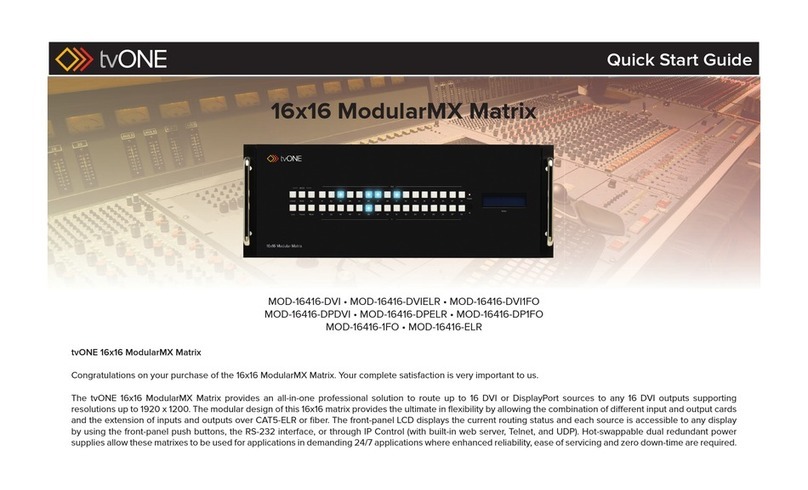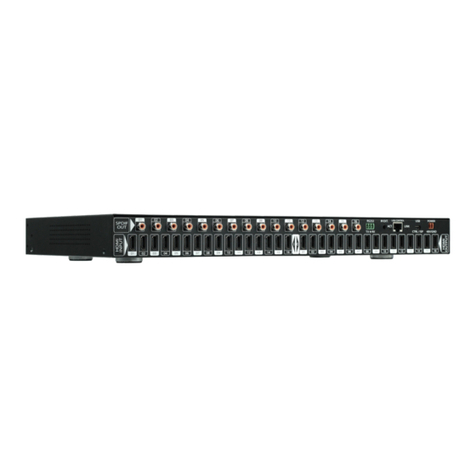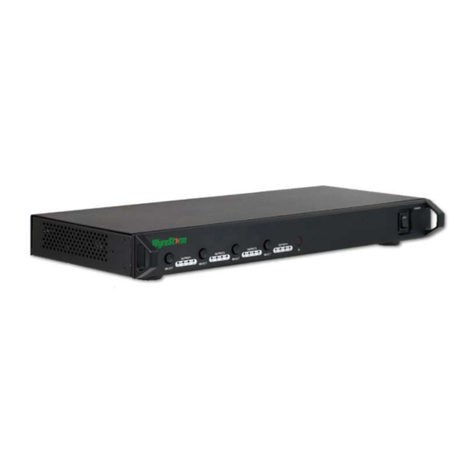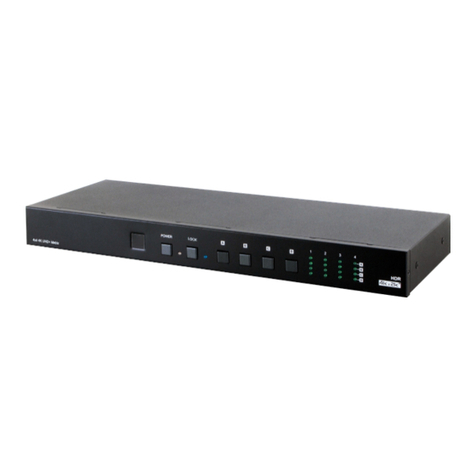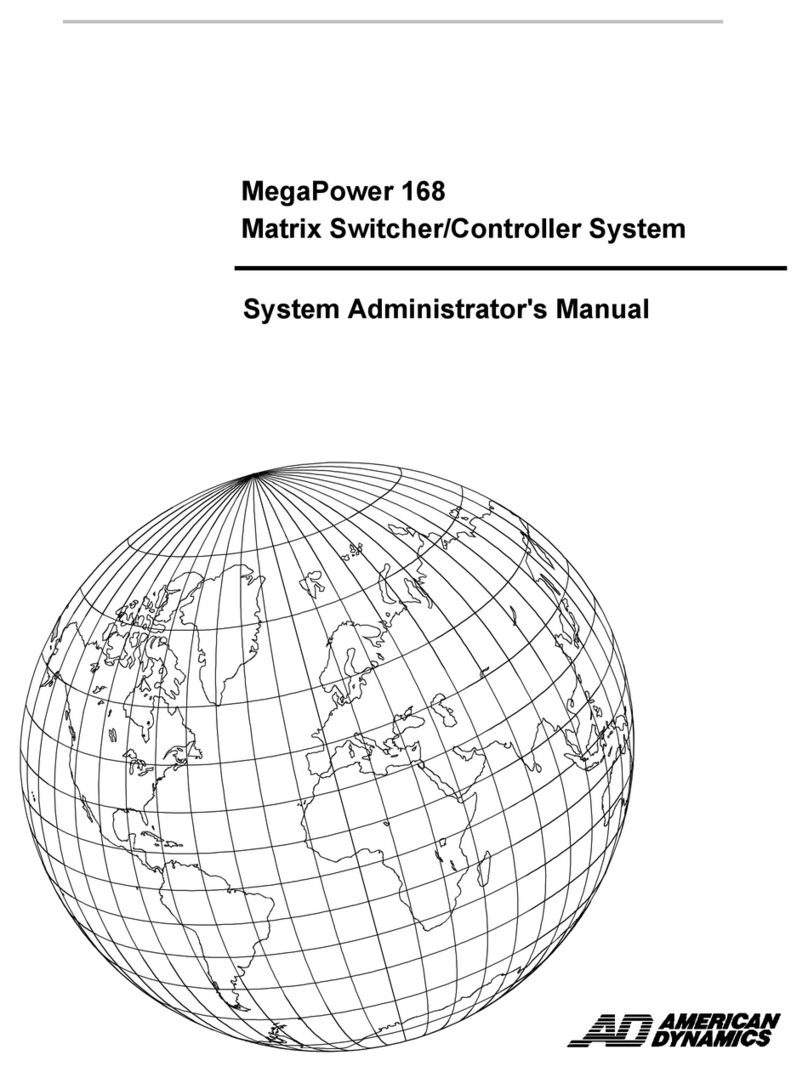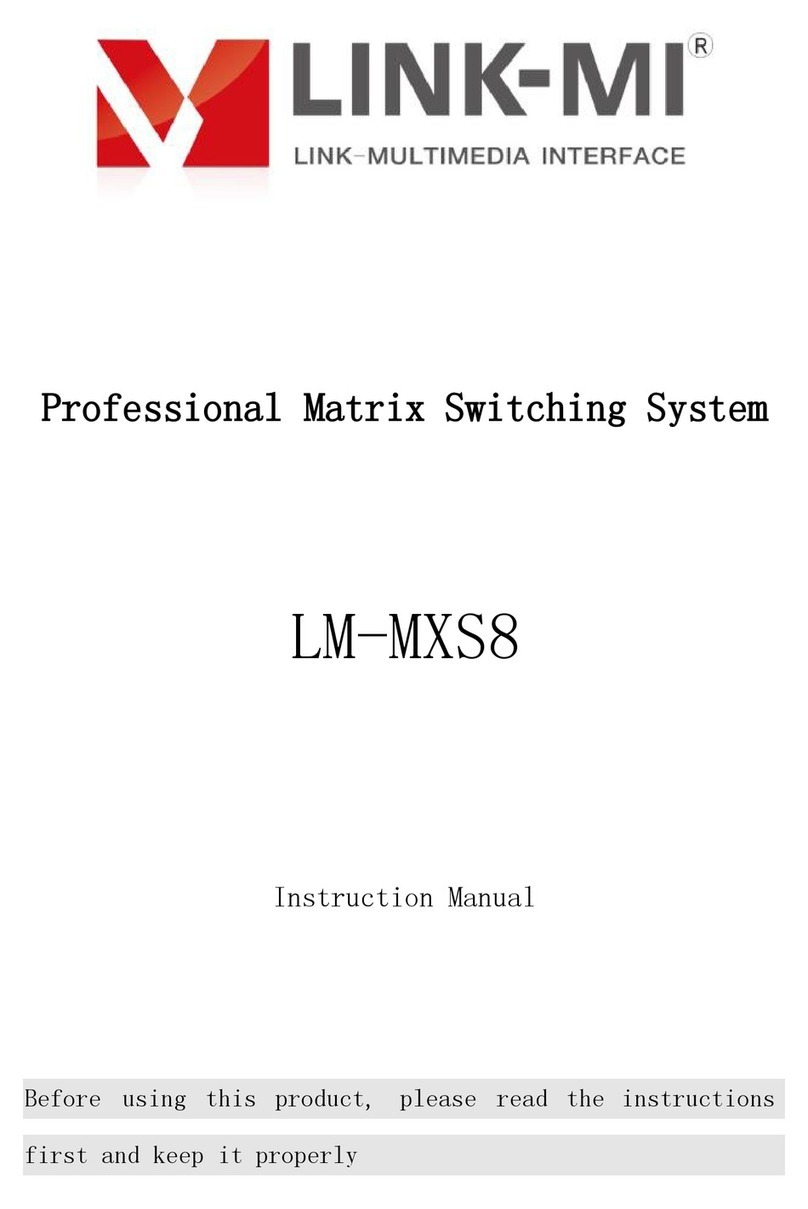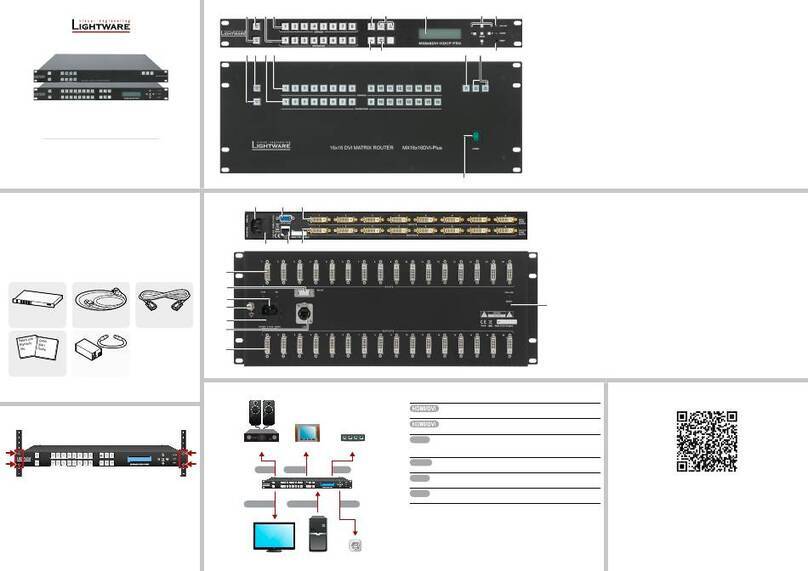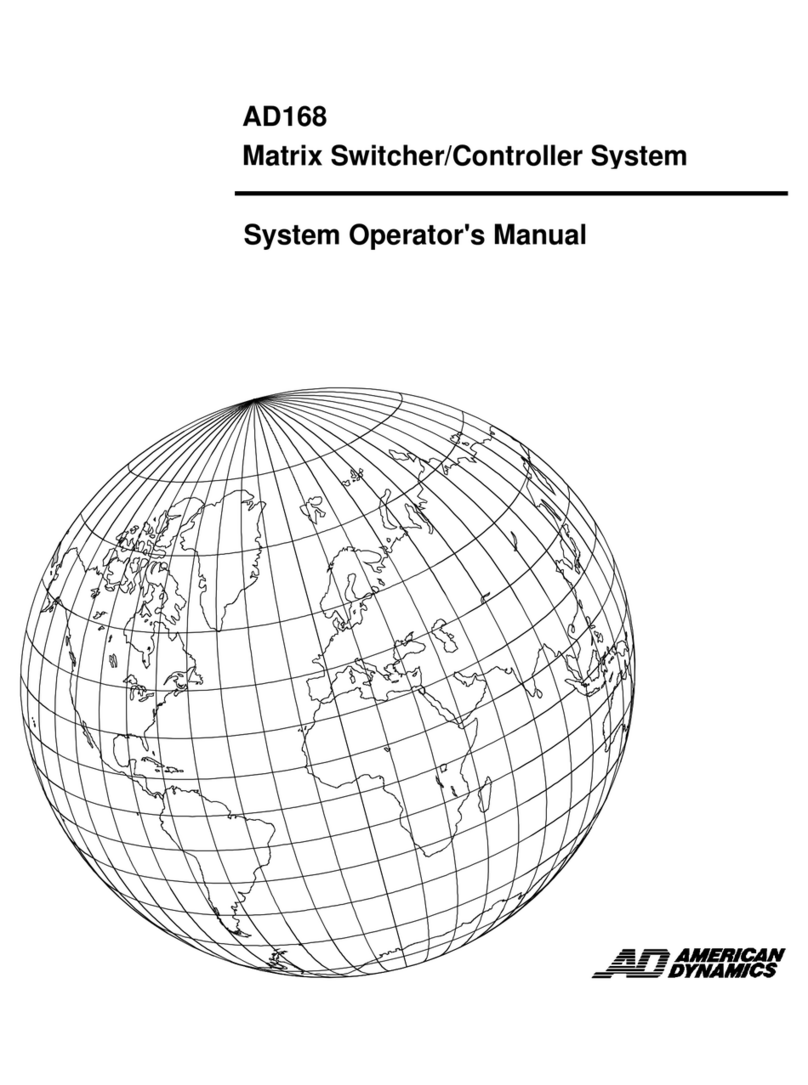Next PROAUDIO M804DSP User manual

INSTALLATION GUIDE / USER MANUAL
M804DSP

Technical and Safety Notices
Please read the following important technical, safety
and environmental notices before installing and using
your amplier.
Technical Notices
All reasonable design and engineering steps have been taken
to ensure that these ampliers always perform satisfactorily
in their intended application and environment and will provide
appropriate levels of support to ensure that all reasonable
customer needs and expectations are met. Such support
however is contingent on the following provisions.
1. These ampliers are Class-I products and should be installed
with a mains cable including the required earth connection to
comply with the Safety Class-I.
2. These ampliers should always be installed by competent
and qualied personnel. Amplier damage or failure caused
by installation or operational errors may invalidate support,
warranty or guarantees of performance.
3. These ampliers are not suitable for use in locations where
they may be accessible to minors.
4. These ampliers are intended to be used specically for the
amplication of audio signals and for connection to moving-coil
loudspeaker systems. Use of these ampliers for amplication
of signals outside the audio band (20Hz to 20kHz) or to drive
transducers other than moving-coil loudspeakers may invalidate
support, warranty or guarantees of performance.
5. These ampliers should only be used within professionally
installed and congured audio systems comprising input
and output ancillary equipments that is known to be of an
appropriate level of performance and in good operating
condition. Any damage to, or unsatisfactory performance from,
these ampliers caused by inadequate or failed input or output
ancillaries may invalidate support, warranty or guarantees of
performance.
6. These ampliers are intended to be installed and operated
indoor in a controlled environment (pollution degree, PD2)
within an ambient temperature range of 0°C to 40°C. These
ampliers are not intended for use above 2000 meters above sea
level. Ampliers installed or operated in environments outside
these limits may invalidate support, warranty or guarantees of
performance.
7. Specic warranty terms are the responsibility of the amplier
re-seller.
Safety and Environmental Notices
Note: The intent of the lightning ash with arrowhead symbol in a
triangle is to alert the user to the presence of uninsulated “dangerous”
voltage within the product’s enclosure that may be of sufcient
magnitude to constitute a risk of electric shock to humans.
Note: The intent of the exclamation point within an equilateral
triangle is to alert the user to the presence of important safety, and
operating and maintenance instructions in this manual.
WARNING! TO PREVENT FIRE OR ELECTRIC SHOCK,
DO NOT EXPOSE THIS EQUIPMENT TO RAIN OR
MOISTURE.
Ambient Temperature Note: If this equipment is
operated in a conned or multiple rack installation, the
internal ambient operating temperature may exceed
the external ambient temperature. It is
important to ensure in these circumstances
that the published maximum operating
temperature for the equipment is not
exceeded.
Reduced Air Flow: Ensure that rack or
other closed installation does not restrict
the cooling airow required for safe and
reliable operation of the equipment.

Technical and Safety Notices
Important Safety Instructions
1. Read these instructions.
2. Keep these instructions.
3. Heed all warnings.
4. Follow all instructions.
5. Do not use this apparatus near water.
6. Do not submerge the equipment in water or liquids.
7. Do not use any aerosol spray, cleaner, disinfectant or
fumigant on, near or into the equipment.
8. Clean only with a dry cloth.
9. Do not block any ventilation opening. Install in accordance
with the manufacturer’s instructions.
10. Do not install near any heat sources such as radiators, heat
registers, stoves, or other apparatus (including ampliers)
that produce heat.
11. To reduce the risk of electrical shock, the power cord shall
be connected to a mains socket outlet with a protective
earthing connection.
12. Do not defeat the safety purpose of the polarized or
grounding type plug. A polarized plug has two blades with
one wider than the other. A grounding type plug has two
blades and a third grounding prong. The wide blade or the
third prong are provided for your safety. If the provided
plug does not t into your outlet, consult an electrician for
replacement of the obsolete outlet.
13. Protect the power cord from being walked on or pinched
particularly at plugs, convenience receptacles, and the point
where they exit from the apparatus.
14. Do not unplug the unit by pulling on the cord, use the plug.
15. Only use attachments/accessories specied by the
manufacturer.
16. Unplug this apparatus during lightning storms or when
unused for long periods of time.
17. Refer all servicing to qualied service personnel. Servicing
is required when the apparatus has been damaged in any
way, such as power supply cord or plug is damaged, liquid
has been spilled or objects have fallen into the apparatus,
the apparatus has been exposed to rain or moisture, does
not operate normally, or has been dropped.
18. The appliance coupler, or the AC Mains plug, is the AC mains
disconnect device and shall remain readily accessible after
installation.
19. Adhere to all applicable, local codes.
20. Consult a licensed, professional engineer when any doubt or
questions arise regarding a physical equipment installation.
Environmental Statement
This product complies with international
directives, including but not limited to the
Restriction of Hazardous Substances (RoHS)
in electrical and electronic equipment, the
Registration, Evaluation, Authorization and
restriction of Chemicals (REACH) and the
disposal of Waste Electrical and Electronic Equipment (WEEE).
Consult your local waste disposal authority for guidance on how
properly to recycle or dispose of this product.

Introduction and Overview
1. Introduction
M804DSP power ampliers have been designed to
provide congurable, consistent and reliable high
performance audio power amplication for residential,
commercial and entertainment applications.
This manual covers the features, installation and
functions of the M804DSP IP500.2, IP800.2, IP500.4
and IP800.4 models. Please read the manual fully
before installing and using an amplier. If you have any
questions regarding amplier conguration, installation
or operation please contact the appropriate customer
support portal.
Following this introduction, the manual is divided into sections
covering the following topics:
• 2. Overview
• 3. Carton Contents
• 4. Installation
• 5. Conguration
• 6. Connections
• 7. Operation
• 8. Specications
2. Amplier Overview
M804DSP ampliers are a full rack width, 2U format power
ampliers that can drive both conventional low impedance (Lo-Z,
4Ω to 16Ω) loudspeakers and high impedance (Hi-Z, 70V/100V)
transformer coupled loudspeakers. They provide four analog
inputs, one stereo S/PDIF digital input, and either two or four
outputs (Lo-Z mode), or one or two outputs (Hi-Z or Lo-Z BTL
mode). M804DSP amplier model output channel counts and
power outputs are as follows:
M804DSP
Mode Channels Max Rated Output per Channel
Lo-Z Four 750 Watts
Lo-Z (BTL) Two 1500 Watts
Hi-Z Two 1500 Watts
Note: In Lo-Z BTL (bridge-tied load) mode, two amplier output
channels are combined to create a single, double power output
channel. BTL mode can be engaged via the amplier Output Mode
conguration setup menu described in Section 5 of this manual.
2.1 Connections and Power Switching
M804DSP signal input and output connections are accomplished
via RCA Phono and Euroblock style connectors. A GPIO (General
Purpose In/Out) Euroblock connector enables some amplier
functions to be controlled externally, and wireless or RJ45
socket Ethernet network connection options are also provided.
Cable connectors and connections are described and illustrated
in Section 6 of this manual
M804DSP ampliers incorporate a front panel mounted power
button. Press the button once to switch the amplier on or off.
Amplier power management behaviour can be congured via
the Control web app Settings Menu described in Section 5 of
this manual.

Introduction and Overview
2.2 Network Features
M804DSP ampliers are TCP/IP network connected devices
that require a wired or wireless network connection to access
their conguration menus. The conguration menus are
accessed via the Control Web App interface and cover Input,
Zone, Output and General Settings functions. The Control
web app conguration menus are described in Section 5 of this
manual.
2.3 Firmware
This manual describes the features, functions and user interface
of M804DSP ampliers running Firmware Version 1.4.0.
It is strongly recommended that the rmware version installed
in the amplier in use is checked initially, and regularly
thereafter. If updated rmware is available, the amplier
should be updated as a priority.
The rmware installed in the amplier can be identied and
updated by selecting the Device option in the Control web app
Settings Menu. Firmware versions can be checked, and rmware
downloaded, from the website:
https://www.nextaudiogroup.com/en/product/m804-dsp
3. Carton Contents
M804DSP ampliers are shipped in a cardboard carton
containing the amplier unit, a mains cable appropriate for the
sales territory, an accessory pack, and a document pack. The full
contents is listed below.
• Amplier unit
• Rack mount ears (tted)
• Mains power cable
• Input connector x 2
• GPIO socket connector
• Output connector x 1 or 2
• Adhesive rubber feet x 4
• Document pack

Installation
Diagram 4A
M804DSP ampli er dimensions.
(Shaded area de nes ventilation space.)
440 mm
17.3 in
332 mm
13.1 in
4. Installation
4.1 Ampli er Location
M804DSP ampli ers are shipped with rack “ears” attached and
are primarily intended for standard (19 inch)equipment rack
installation. If not to be installed in an equipment rack, M804DSP
ampli ers can be placed free-standing on a at surface. Adhesive
rubber feet are supplied for this purpose.
It is important that any installation provides space for air ow
through the ventilation apertures at the front and rear of the
ampli er. This is illustrated in Diagram 4A.
88 mm
3.5 in

Conguration
5. Conguration
Before making input, output and GPIO connections,
an initial M804DSP amplier conguration should
be established. It is particularly important that the
amplier output format is congured appropriately for
the speakers that are to be connected.
Conguration requires that M804DSP ampliers are
connected to mains power, switched on and connected
to network services. These connections are described in
the following two sections.
5.1 Mains Power Connection
M804DSP ampliers incorporate a power factor corrected
power supply and can be used with mains input voltage from
100V AC to 240V AC, 50/60Hz. Use the mains cable supplied
with the amplier and connect it to a mains supply.
Press the front panel power button to switch on the amplier.
After a short delay the front panel Status indicator will illuminate
green.
5.2 Network Services
M804DSP ampliers are congured via the Control
Web App interface. Before the Web App conguration
menus can be accessed, M804DSP ampliers must be
connected to the same TCP/IP network as the computer
or mobile device that is to be used for conguration.
5.2.1 Wired (Ethernet) Network Connection
To connect a M804DSP amplier to a TCP/IP network using a
wired connection (Ethernet) follow the steps below.
1. Use an Ethernet cable to connect the M804DSP amplier
rear panel Network Control socket to a free socket on a network
router or switch, or directly to an Ethernet equipped laptop or
desktop computer.
2. Connect the M804DSP amplier to mains power using the
supplied mains cable. Wait for the front panel Network indicator
to illuminate green to indicate that the amplier has network
connectivity.
3. The M804DSP amplier default LAN IP address is
192.168.64.100. Congure the laptop or desktop computer
for a xed IP address in the same IP range; eg. 192.168.64.10,
with Subnet mask of 255.255.255.0 (or prex 24) and set the
Gateway to 192.168.64.1.
4. Open a laptop or desktop web browser and enter the address
http://192.168.64.100. The Control Web App interface will
open to enable amplier conguration as required.
Note: M804DSP ampliers can be congured to use DHCP for
network connection if required. However, if a M804DSP amplier
using DHCP is power cycled, it is possible that the TCP/IP network
router will assign it a different IP address, leaving its conguration
page inaccessible via the previous address. If this occurs, a network
scanning app can be used to identify the new IP address. DHCP and
Fixed IP address option settings can be found in the Settings Tab
menu described in Section 5.3.
5.2.2 Wireless (WiFi) Network Connection
To connect a M804DSP amplier to a TCP/IP network using a
wireless connection (WiFi) follow the steps below.
1. With the M804DSP amplier connected to mains power, wait
for the front panel WiFi indicator to illuminate green.
2. Use a mobile, laptop or desktop device to search for available
WiFi networks. Connect to, NEXT-proaudio M804DSP (product
serial number)’ using the password, ‘password’. The amplier
serial number can be found on its rear panel.
3. Open a computer or mobile device web browser and enter the
IP address: 192.168.4.1. The Control Web App interface will
open to enable amplier conguration as required.
4. Select the Web App Settings Tab followed by WiFi > WiFi
Mode > Client to congure the amplier to connect to the
required WiFI network. The WiFi network name and password
will be required.
It is strongly recommended that the M804DSP amplier
Access Point WiFi password is changed following initial
wireless connection.

Conguration
5.3.1 Input Tab
The Input Tab provides the following conguration parameters
for each amplier input channel:
• Input name
• Mono/Stereo selection
• Input sensitivity
• High-pass lter
• Gain trim
• Five band equalisation
The Input Tab also enables input signals to be mixed and routed
to specic amplier zones. The mix function enables any
amplier input, including stereo or split mono S/PDIF inputs,
to be grouped with any other input or inputs to create multiple
predened mixes.
Note: The number of individual mixes possible is equal to the number
of amplier analogue inputs.
Note: Mix inputs are muted by default with their level adjustment
sliders set to zero.
Mix operations take place following high-pass lter, input
equalisation and mono/stereo selection.
Diagram 5A
Conguration Dashboard display
Diagram 5B
Input Tab display
(two inputs only shown)
Input name - type to edit
Select mono or stereo
Select input sensitivity option
Adjust input gain
Open EQ window
Adjust zone volume
Adjust zone volume
Note: When adjusting input gain, the input level display should
remain green. If it displays red, the input gain should be reduced.
5.3 Conguration Menus
Opening a web browser that is network connected to a
M804DSP amplier initially displays the M804DSP Control
Web App Dashboard illustrated in Diagram 5A. The Dashboard
is the ‘home’ page from which all other conguration options can
be accessed.
The Dashboard displays the amplier status, output zones and
the conguration menu tabs. It also enables immediate access
to zone volume control The functions available under each
conguration menu tab are described in the following sections.
Select input type

Conguration
Diagram 5C
Input EQ display
Diagram 5D
Input Mix display
A pink noise or sine wave audio signal generator, appropriate for
audio system testing and set up, can also be enabled, disabled,
and adjusted for gain and frequency via the Input Tab. Diagrams
5B, 5C and 5D illustrate the Input Tab, Input EQ and Input Mix
displays respectively.
5.3.2 Zone Tab
The Zone Tab enables installation zones to be dened and named,
and provides access to further sub-menus. Zones might be bar or
restaurant areas for example, or different rooms in a home. For
all Zone Tab menus, the installation zone under conguration is
selected by highlighting one of the zone identiers (A, B, C or D)
at the top of the display. Diagram 5E and 5F illustrates the Zone
Tab and Source menu displays.
• The Source menu enables inputs to be assigned to zones and
Input Priority or Input Ducking to be congured. The Input
Priority function enables an alternative input to replace
and mute the input primarily routed to the zone under
conguration when the alternative input exceeds a preset
level.
The Input Ducking function enables an alternative input to
replace and attenuate the input primarily routed to the zone
under conguration when the alternative input exceeds a preset
level.
Zone name - type to edit
Select zone
Select mix function
Select mono or stereo
Select zone input
Congure zone volume options
Congure zone restrictions
Congure zone compressor
Adjust zone volume
Diagram 5E
Zone Tab display
Select and adjust required EQ stages
Mix name - type to edit
Adjust mix input level

Conguration
Note: Input Priority and Input Ducking parameters can be either set
to default values or their Threshold, Attack, Hold and Release values
set as required. Input Priority can also be set to ignore the volume
level set for the specied zone and take a specic override volume.
• The Volume menu allows minimum and maximum zone
volume limits to be set, and enables external GPIO volume
control to be applied to individual zones. The GPIO
conguration menu can be found under the Settings Tab,
and notes on connecting an external volume control via the
GPIO interface can be found in Section 5.5 of this manual.
Note: If an amplier is controlled via a third-party control system API,
volume level limits set via the Input Tab will not apply.
• The Restrictions menu enables zone inputs or input mixes to
be restricted from routing to particular zones.
Note: Routing restrictions cannot be applied to priority zone inputs.
Note: If an amplier is controlled via a third-party control system API,
input routing restrictions set via the Input Tab will not apply.
• The Compressor option enables default or custom signal
compression to be applied to individual zones.
Note: Compression can be useful to reduce the volume difference
between loud and quiet audio material. The lower the compression
threshold is set, the more the difference between loud and soft will
be reduced. The overall zone volume may need to be increased
when compression is used. The default compression parameters are
appropriate for most installations.
5.3.3 Output Tab
The Output Tab enables amplier outputs to be named, linked
to zones, and provides access to Delay, Equalizer and Speaker
Preset menus. Diagram 5G illustrates the Output Tab display.
For all Output Tab menus, the amplier output under
conguration is selected by highlighting one of the output
identiers (1, 2, 3 or 4) at the top of the display.
Note: The number of individual outputs available for conguration
will depend on the M804DSP amplier model and the input, zone
and output mode conguration.
• The Routing menu enables zones to be assigned to amplier
outputs.
Note: Routing for zones specied as stereo will automatically offer
three output options: left channel, right channel or summed mono.
The summed mono signal can potentially be used to drive a mono
subwoofer.
• The Delay menu enables delay to be applied to individual
amplier outputs.
Output name - type to edit
Select output
Enable and congure output delay if required
Dene output routing
Enable and congure output EQ if required
Congure and manage speaker presets
Diagram 5G
Output Tab display
Diagram 5F
Zone Source menu display
Select zone

Conguration
• The Equalizer menu enables parametric equalization to be
applied to individual amplier outputs. Equalizer settings
congured for one amplier output can be copied and
applied to other outputs.
• The Speaker Preset menu enables a set of speaker
parameters to be adjusted, and preset congurations to be
created, exported, imported or cleared.
Speaker Presets can be simply applied to the selected
amplier output or imported, chosen from a library, exported
or cleared. The preset congurations can include any or all of
the parameters described in Section 5.3.4 and can be locked
to prevent inadvertent modication. Diagrams 5H to 5K
illustrate the application of speaker presets.
Speaker Preset data provided by third parties for use with
specic speakers can be imported and applied to amplier
outputs. To import speaker preset parameters follow the
steps described below and illustrated in the diagrams.
1. Select either the IMPORT PRESET FROM LIBRARY
or SELECT PRESET FROM FILE option from the
Speaker Preset menu. If no import option is visible,
select CLEAR to delete any existing speaker preset
data.
Note: The SELECT PRESET FROM LIBRARY option will be unavailable
if no speaker preset libraries have been created. Speaker preset library
creation and management is described in Section 5.3.5.
2. Select the appropriate ‘.zcp’ format speaker preset
data le to import from either a Library or a
computer folder. The preset data will be applied
to the selected amplier output as soon as the le
import is complete.
3. If the Speaker Preset data requires modication it
can be customized by selecting the CUSTOMIZE
PRESET option.
Note: If an imported Speaker Preset data le includes locked
parameters, they will be unavailable for modication.
5.3.4 Speaker Preset Menu Parameters
• The Crossover & Gain preset menu enables high or low-
pass crossover lters and gain adjustment to be applied to
individual amplier outputs.
• The Speaker EQ preset menu enables parametric
equalization to be applied to individual amplier outputs.
• The FIR preset menu enables FIR (Finite Impulse Response)
Select to congure
Select to congure
Select to congure
Select to congure
Select to congure
Select to congure
Select to congure
Select to congure
Diagram 5H
Speaker Preset Parameters
Diagram 5I
Speaker Preset import le selection
Select output

Conguration
Diagram 5J
Speaker Preset applied
Diagram 5K
Speaker Preset parameter adjustment
based equalization lter coefcients generated by external
speaker measurement software to be imported and applied
to individual amplier outputs.
Note: FIR coefcient les in either .csv or .txt format can be imported.
• The Driver Alignment preset menu enables delay to be
applied to individual amplier outputs.
• The Polarity preset menu enables the polarity of individual
amplier outputs to be reversed.
• The Limiter preset menu enables signal limiting to be
engaged or bypassed on individual amplier outputs. Clip
limiting, Peak limiting and RMS limiting can be individually
or collectively engaged. The Clip limiting function offers
Fast and Normal response time options. The Peak limiting
function can be set to either Automatic or Manual parameter
values. The RMS Limiter has default parameter values that
can be adjusted but has no automatic option.
Note: It is strongly advised that if an amplier is driving low impedance
loads (<4Ω) the Clip Limiter should be engaged and set to Fast.
Note: In automatic mode, the peak limiter parameters adjust
automatically in response to Crossover & Gain high-pass lter
settings.
• The Output Mode preset menu enables individual amplier
outputs to be switched off or congured for Lo-Z or
Hi-Z modes. In Hi-Z modes, a high-pass lter can also be
congured and applied to the output. The number of outputs
available will depend on the amplier model, input setup and
zone setup. For example, a two output amplier will have
two outputs available if Lo-Z mode is selected but only one
output available if Hi-Z mode is selected.
Note:: Use of a high-pass lter with Hi-Z mode loudspeakers is useful
to avoid the possibility of distortion caused by low frequency line
transformer saturation. Begin with the default lter setting of 70Hz.
If low frequency distortion is still audible, increase the frequency
setting one step at a time until the distortion is no longer audible.
5.3.5 Settings Tab
The Settings Tab enables miscellaneous amplier settings to be
congured and installation data to be recorded.

Conguration
Diagram 5L
Settings Tab menu
Diagram 5M
The External Devices display
External device - tap to congure
The Settings Tab provides access to further sub-menus. Diagram
5L illustrates the Settings Tab.
• The System Information menu provides text elds for the
recording of installation data.
• The Device menu records amplier specic information
such as the model number and rmware version. A rmware
update routine and identier button can also be found under
the Device menu.
• The External Devices menu enables control panels to be
paired with an amplier and congured. Each individual
amplier zone to be controlled will require its own control
device. Diagram 5M illustrates the External Devices display.
• The Backup & Restore menu enables amplier conguration
data to be downloaded to an external archive, and enables
previously saved conguration les to be uploaded and
adopted by the currently connected amplier.
• The Speaker Library menu enables management of speaker
preset libraries. Existing libraries of speaker preset les (.zcl)
can be created or imported, and existing libraries edited
or fully deleted. Diagram 5N illustrates the creation and

management of speaker preset libraries.
• The Security menu enables a password to be set in order to
protect against unauthorised access to the amplier Control
Web App. Password protection is particularly important
when an amplier is connected to a wired network as the
a WiFi password is no longer required to gain access to
Control Web App.
Note: It is recommended that a Control Web App password is different
from that required to gain access to the amplier via WiFi.
• The Power Management menu enables various automatic
switch-on options to be engaged. The Power Management
menu also offers timed Standby and Mute functions.
• The Output Routing menu enables specied inputs or zones
to be routed to the amplier S/PDIF outputs. The output
level can also be adjusted.
Any zone or input can be routed to either digital output,
including inputs not actively assigned to a zone. Primary
or priority input status is immaterial. The specied input is
always routed to the specied output to be available for use
by downstream devices.
Note: The digital output function is especially useful when ampliers
are to be daisy chained and a specic input; a central paging mic, for
example, is required to be routed to multiple ampliers..
• The GPIO menu enables conguration of the multi-purpose
GPIO interface pins.
• The LAN menu enables conguration and reset of the wired
network options and parameters.
• The WiFi menu enables conguration and reset of the
wireless network options and parameters.
Conguration
Diagram 5N
Speaker Library Creation and Management
Library name - type to edit
Library version - type to edit
Import preset data (.zcp) to library
Creat new library
Rename library
Delete library

Conguration
Diagram 5O
Signal Flow Schematic
(four output amplier)
5.4 Setup and Signal Routing
Thanks to their network based conguration features,
M804DSP ampliers offer considerable versatility in terms of
sources, signal routing, installation zones and output modes.
Inputs can be freely assigned to installation zones, and those
zones assigned freely to the available amplier outputs in either
Lo-Z or Hi-Z modes.
This versatility enables, for example, one amplier
simultaneously to drive both Lo-Z and Hi-Z speakers, or for
different inputs to be routed to different output zones.
The following paragraphs describe and illustrate the
recommended procedure for conguring input, zone and output
routing. A general signal ow schematic is also illustrated in
Diagram 5O.

Conguration
5.4.1 Input Setup
Open the conguration Dashboard and select the Input Tab. The
Input Tab is shown in Diagram 5B.
• To edit default input names simply select and type in the
Input Name eld.
• Dene a mono or stereo input by selecting the appropriate
option. Dening a stereo input will reduce the total number
of discrete inputs available.
• Select an input sensitivity option from the drop-down menu:
+14dB, +4dB, -10dB and ‘microphone’ options are available.
Generally, the +14dB or +4dB options are appropriate
for ‘professional audio’ source hardware with balanced
outputs, while the -10dB option is more appropriate for
‘consumer audio’ source hardware with unbalanced outputs.
The ‘microphone’ option provides the signicantly greater
sensitivity required for microphones.
Note: Only dynamic microphones are suitable for connection.
Phantom power for condenser microphones is not provided.
• If necessary, adjust the input gain using the slider or up/down
icons. Gain adjustment is intended to be used for ne output
level adjustment following initial use.
5.4.2 Zone Setup & Routing
Open the conguration Dashboard and select the Zone Tab. The
Zone Tab is shown in Diagram 5E.
• Select the zone to be congured. The number of zones
available and their channel format (stereo or mono) will
depend on the amplier model, input setup and output
mode (Lo-Z or Hi-Z). For example, a two output amplier
can have the following zone congurations:
• 1 x stereo Lo-Z zone
• 2 x mono Lo-Z zones
• 1 x mono Hi-Z zone
• A four output amplier can have the following zones
congured:
• 2 x stereo Lo-Z zones
• 4 x mono Lo-Z zones
• 2 x mono Hi-Z zone
• 1 x mono Hi-Z zone + 1 x stereo Lo-Z zone
• 1 x mono Hi-Z zone + 2 x mono Lo-Z zones
Note: When congured in Hi-Z mode M804DSP ampliers operate
in ‘bridged’ mode where the output of two channels is combined. This
means that the number of output channels available in Hi-Z mode is
half that available in Lo-Z mode .
Note: Mono signals might be mono at source, created though
combining the left and right channels of a stereo signal (summed
mono) or treating the left and right channels of a stereo signal
independently (split mono).
• Name zones by typing in the Zone Name eld.
• Adjust the zone volume if required by using the slider.
• Dene a mono or stereo zone by selecting the appropriate
option. Dening a stereo zone will reduce the total number
of further zones available.
• Specify an input for the zone by selecting from the drop-
down menu. Selecting a stereo input for a mono zone will
automatically sum the stereo channels to mono.

Conguration
5.5 GPIO Setup and Connection
M804DSP ampliers provide a GPIO socket that enables
remote control of volume, standby, mute and trigger functions.
The GPIO connector pin functions are described in the GPIO
Settings menu illustrated in Diagram 5P. The connection of
GPIO based remote volume control and standby/mute are
illustrated in Diagram 5Q and Diagram 5R respectively.
Note: The GPIO connector must not be used for any unintended
purpose. Amplier damage may result from incorrect use of
GPIO.
Note: Shielded cable must be used when connecting standby
switches and potentiometers via GPIO.
Note: GPIO Pin 8 has a low output impedance and is able to
supply a maximum current of 10mA.
Note: GPIO Pin 1 and Pin 3 both offer ground connections:
Pin 1 is connected directly to the amplier chassis.
Pin 3 is connected to the chassis via a 220 Ohm resistor.
The ‘soft ground’ connection of Pin 3 is potentially useful for
managing ground loops that may cause audible hum.
Diagram 5P
GPIO Settings Menu
Diagram 5Q
Potentiometer connections for remote vol-
ume control via GPIO.
Note: Diagram 6D illustrates
use of the GPIO connector.
Diagram 5R
Connections for remote
standby/mute switch via GPIO.
Note: Diagram 6D illustrates
use of the GPIO connector.
Ground
+3V3
Expansion
Port
Ground
Standby/Mute
Expansion
Port
Potentiometer
(>10kΩ)
Connect Wiper to
Pin 4, 5, 6 or 7. Switch open or closed
toggles Standby or Mute
depending on options
selected in the GPIO
Settings Menu

Connections
6. Connections
M804DSP amplier rear panel connections are
illustrated in Diagrams 6A.
6.1 Mains Power Connection
M804DSP ampliers incorporate a power factor corrected
universal power supply and can be used with mains input voltage
from 100V AC to 240V AC, 50/60Hz. Use the mains cable
supplied with the amplier.
M804DSP ampliers incorporate a front panel mounted power
button. Press the button once to switch the amplier on or off.
Ensure that all signal, GPIO and output connections are made
before switching on the amplier.
6.2 Input Connection
M804DSP amplier provide four balanced or unbalanced
analog audio inputs and a stereo S/PDIF digital audio input. Any
input channel can be routed to any output channel. Input routing
options can be congured via the Control Web App Input Tab.
See Section 5 of this manual.
Analog Inputs
M804DSP analog inputs are of line level format with a default
input sensitivity of +4dBu (full output voltage swing/sensitivity)
in all output modes. Depending on the selected sensitivity,
the inputs can handle up to +24dBu without clipping. Input
sensitivity options can be set via the Control Web App Input
Ta b . See Section 5 of this manual.
Balanced input connections to the ampliers are made via male
‘Euro Block’ connectors. Connecting cables to the supplied
female input connectors is illustrated in Diagram 6B.
Unbalanced input connections to the ampliers are made via
RCA phono sockets connected in parallel with the balanced
inputs.
Diagram 6A
M804DSP rear panel connections.
Note: Two output amplier model connection sockets differ only in
the deletion of channel 3 and channel 4 output connectors.
Digital Outputs
M804DSP Connect S/PDIF stereo digital audio output
connections are made via a single RCA Phono socket. The S/
PDIF output signal can be routed from any input or zone and
is intended to be used for daisy-chaining M804DSP Connect
ampliers.
Note: See the Output Routing paragraphs of Section 5.3.3 for more
information on Digital Output conguration.
Note: 75Ω RCA Phono cables specically intended for digital audio
should always be used for S/PDIF connections. Standard Phono
cables can be used but may not result in optimal performance.
Note: The S/PDIF output level is by default set at -10dB to reduce the
possibility of downstream input clipping.
6.3 Output Connections
Output connections from the ampliers are achieved via male
‘Euro Block’ connectors. Ensure that speaker connection
polarity is correct throughout the installation:
In the case of Lo-Z speaker connections, positive (+) amplier
terminals should always be connected to positive speaker
terminals and negative (–) amplier terminals always connected
to negative speaker terminals.
In the case of Hi-Z speaker connections, the two speaker cable
conductors should be connected between the positive (+)
terminal of Output 1 and the negative terminal (-) of Output 2,
and likewise for Outputs 3 and 4.
Output mode options (Lo-Z or Hi-Z) can be congured via the
Control Web App Input Tab. See Section 5 of this manual.
Connecting cables to the supplied female output connector is
illustrated in Diagram 6C.
Expansion
Port

Cable Gauge Table
Lo-Z installations, 0.5dB attenuation. 2 Ω, 4 Ω & 8 Ω loads
Cable Gauge Table
70V Hi-Z installations, 1.0dB attenuation
20 speakers evenly distributed
Cable Gauge Table
100V Hi-Z installations, 1.0dB attenuation
20 speakers evenly distributed
Cable Cross
Section
(mm2)
Cable Gauge
(AWG)
Max Cable
Length
(Metres, 2 Ω
load)
Max Cable
Length
(Metres, 4 Ω
load)
Max Cable
Length
(Metres, 8 Ω
load)
0.75 ≈18 N/A 5 10
1.5 ≈16 5 10 20
2.5 ≈14 8 17 35
4.0 ≈12 14 28 55
Cable Cross
Section
(mm2)
Cable Gauge
(AWG)
Max Cable Length
(Metres),
(1000 W/channel)
Max Cable Length
(Metres),
(1200 W/channel)
0.75 ≈18 25 20
1.5 ≈16 50 40
2.0 ≈14 80 60
3.5 ≈12 125 100
Cable Cross
Section
(mm2)
Cable Gauge
(AWG)
Max Cable Length
(Metres),
(1000 W/channel)
Max Cable Length
(Metres),
(1500 W/channel)
0.75 ≈18 50 30
1.5 ≈16 100 60
2.0 ≈14 160 100
3.5 ≈12 250 160
Connections
6.4 Speaker Cable Gauge
M804DSP speaker connection cable gauge should be
chosen appropriately to reect the type of installation.
The adjacent tables specify the appropriate cable gauge
and maximum cable length for less than 0.5dB cable loss
in Lo-Z mode and less than 1.0dB cable loss in Hi-Z mode.
6.5 GPIO Connections
If any M804DSP GPIO functionality is required,
cables will need to be connected to the supplied GPIO
connector. Connecting cables to the GPIO connector is
illustrated in Diagrams 6D.
6.6 Network Connections
M804DSP ampliers are TCP/IP network connected
devices that are congured via a web page based interface.
Wired (Ethernet) and wireless (WiFi) connection options
are available. Connecting M804DSP ampliers to a TCP/
IP network is described in Section 5 of this manual

Low-Z Mode
Hi-Z/BTL
Modes
5 mm
5 mm
5 mm
Connections
Diagram 6B
Balanced analog input
cable connections.
Diagram 6C
Output cable connections.
Table of contents
Popular Matrix Switcher manuals by other brands
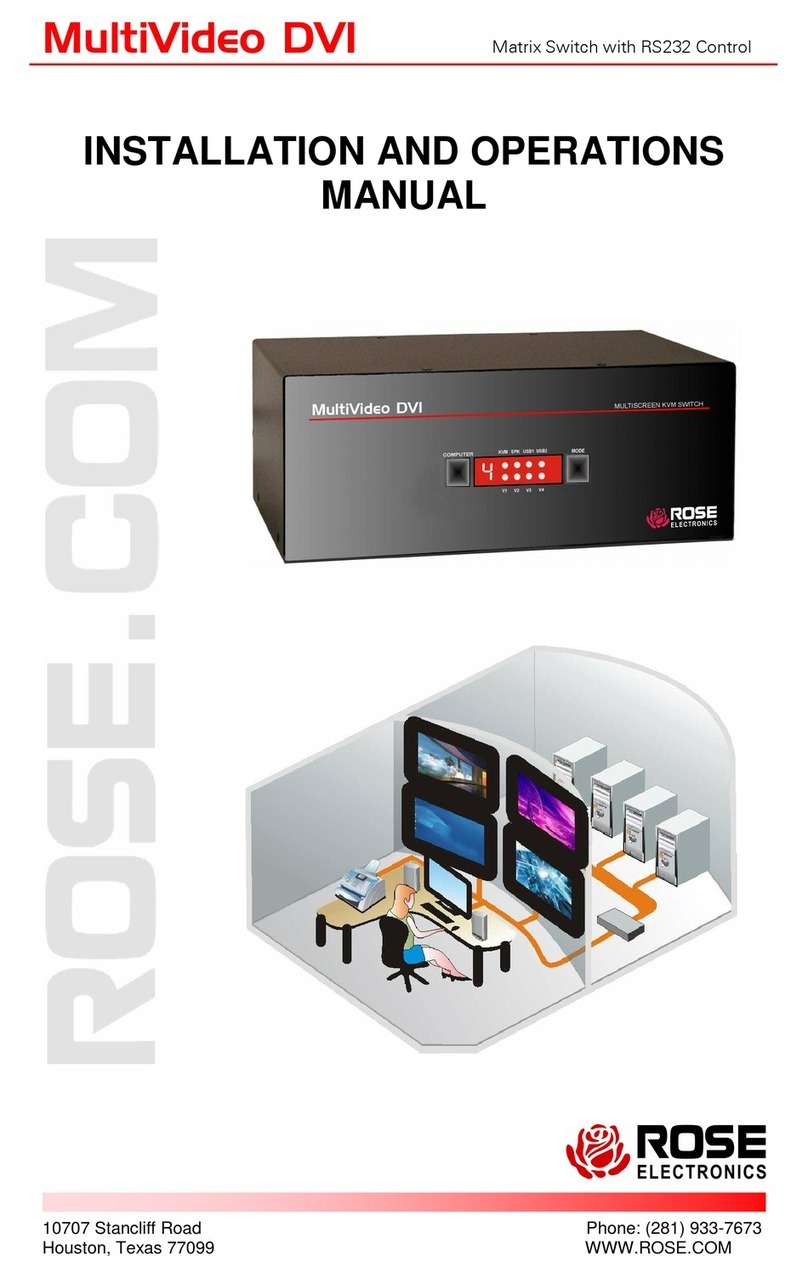
Rose electronics
Rose electronics MultiVideo DVI Installation and operation manual
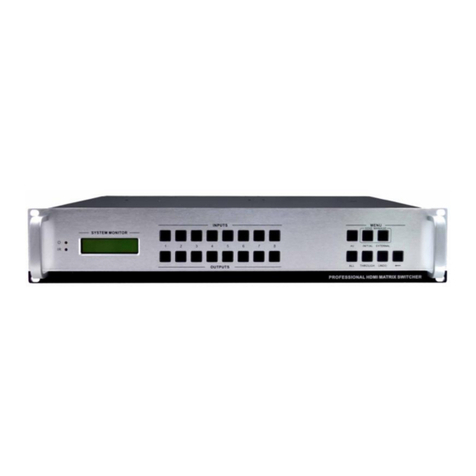
PTN
PTN MHD88 user manual

Extron electronics
Extron electronics MVX VGA A user manual
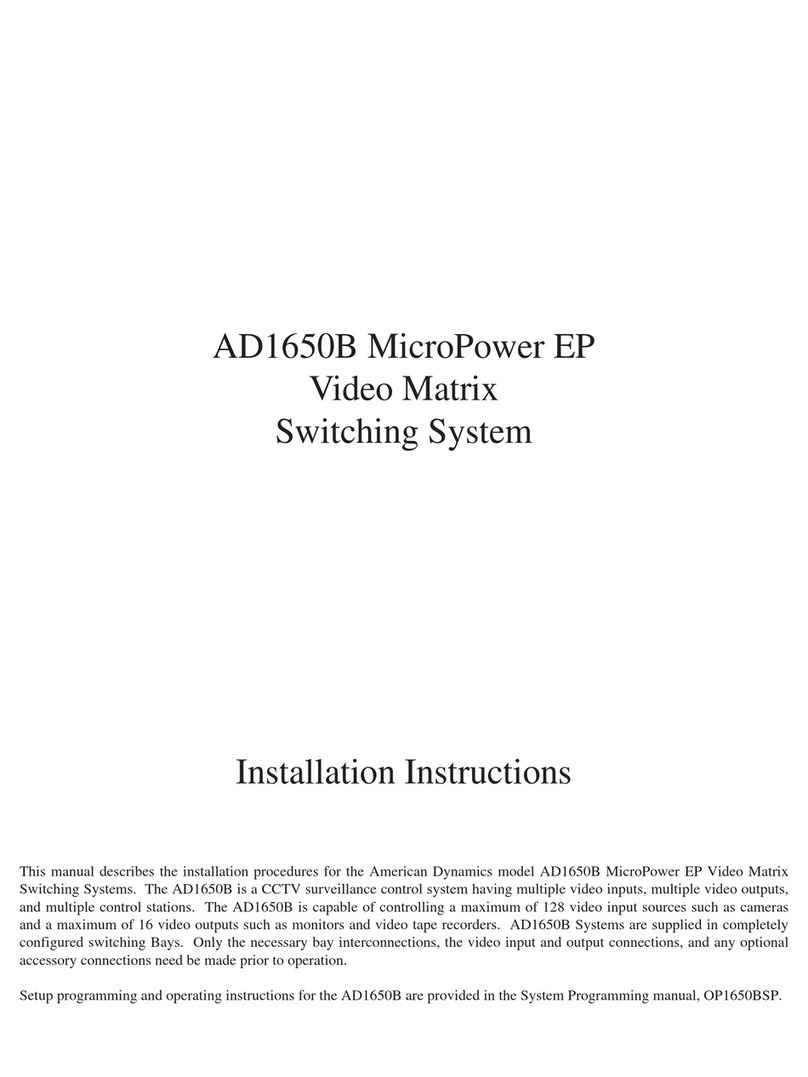
American Dynamics
American Dynamics MicroPower EP AD1650B installation instructions
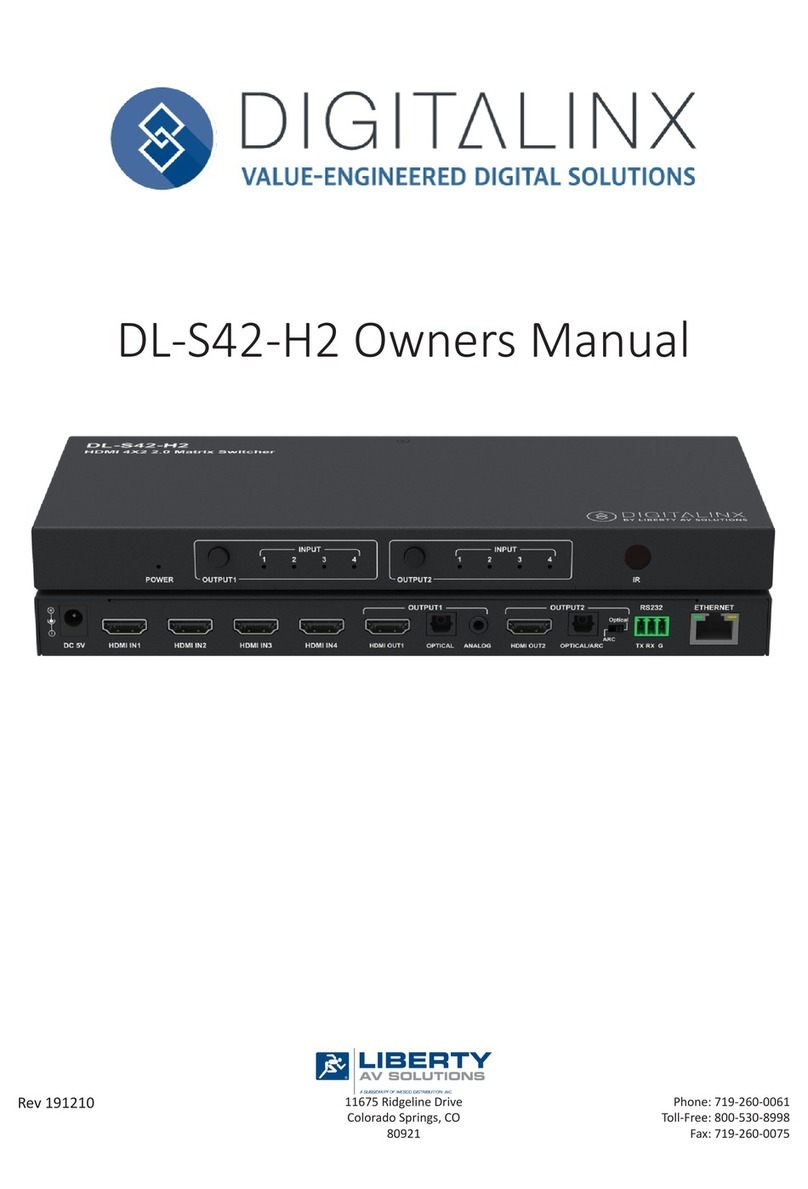
DigitaLinx
DigitaLinx DL-S42-H2 owner's manual
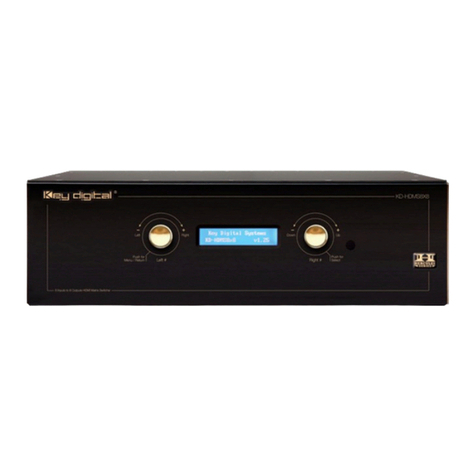
Key Digital
Key Digital KD-HDMS1X15 Setup guide
